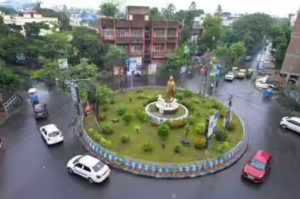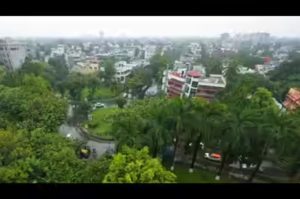Salt Lake Cosmo Para: Tucked away in the planned serenity of Bidhannagar lies a vibrant pocket that embodies the spirit of contemporary Kolkata. What locals now fondly call “Cosmo Para”, an area located within Salt Lake’s Sector I, is more than just a residential block—it’s an evolving cultural canvas, a melting pot of languages, cuisines, professions, and belief systems. In many ways, it mirrors the larger narrative of urban inclusivity sweeping across Bengal’s capital.

From Homogeneity to Heterogeneity: A Neighborhood Transforms
Originally designed in the 1970s as a middle-to-upper-class Bengali stronghold, Salt Lake was intended to be a clean, quiet satellite township. Over the decades, however, Cosmo Para—centered around AB, AC, and AE blocks—has witnessed an organic transformation. The influx of professionals, migrants from other states, expats, and non-Bengali business families has created a rich cultural confluence.
“We speak in Bangla, but we eat Gujarati theplas for breakfast and celebrate Onam with our Malayali neighbors,” laughs Moumita Saha, a third-generation resident.
Housing Patterns Reflect Cultural Diversity
Cosmo Para is home to:
- IT professionals from southern India
- Marwari and Gujarati business families
- Punjabi restaurateurs
- Bihari and Odia civil servants
- Bangladeshi expats in media and academia
The housing mix—private homes, rental flats, PGs, and cooperative societies—has made the area accessible to both the elite and the aspirational middle class. The average rent of a 2BHK ranges between ₹15,000–₹25,000, while larger family homes fetch up to ₹45,000–₹50,000 monthly.
Real estate brokers note an increasing demand for property due to the upcoming metro extension, proximity to Salt Lake Sector V, and good schooling options.


Salt Lake Cosmo Para: A Gastronomic Kaleidoscope
Walk through Cosmo Para on a weekend and you’ll be enveloped in aromas that span India’s culinary map.
- Rajasthan Bhawan offers authentic dal-baati-churma.
- A local Kerala family sells banana chips and payasam during Onam.
- The neighborhood park sees Langar during Baisakhi, courtesy of a Punjabi cultural forum.
- Bengali home cooks collaborate with Assamese neighbors during Poila Boishakh–Bihu fusion potlucks.
“Food brings people together faster than language,” says Nisha Menon, a techie from Kochi. “Here, my sambar is everyone’s comfort food.”
A Mosaic of Religious Plurality
In just one square kilometer, Cosmo Para boasts:
- A Durga puja committee with Tamil, Marwari and Bengali members
- A small Jain Derasar
- A Gurudwara managed by the Salt Lake Sikh Committee
- Regular Ramzan iftar stalls
- A Christmas street concert organized by Anglo-Indian and Goan residents
Even Ganesh Chaturthi, once uncommon in the Bengali calendar, now sees community-level celebrations. These micro-festivals create interfaith bonds and reduce social friction.
Generation Gap Narrows in Cosmo Para
Older residents initially resisted the influx of “outsiders.” But their grandchildren now speak Hindi, English, Tamil, and Punjabi with equal ease.
“My granddaughter made a best friend in school who’s from Manipur. They’re inseparable. I never thought I’d be watching Mizo dance videos on YouTube,” shares Bhaskar Chatterjee, 68, retired government officer.
The younger generation’s openness to linguistic and lifestyle diversity has forced older residents to adapt — leading to a more accepting community ethos.
Excellent Connectivity, Infrastructure & Civic Awareness
With EM Bypass, Bidhannagar railway station, and the newly extended metro lines close by, Cosmo Para’s connectivity is top-notch. This accessibility has made it a preferred location for office-goers from Sector V and New Town.
Kolkata Municipal Corporation and Bidhannagar police have worked to:
- Install better drainage systems
- Set up waste segregation bins
- Create more street lighting and security patrols
- Establish women-friendly zones in parks and jogging tracks
Cultural Confluence in Action
Every year, the Cosmo Para Utsav draws participation from over 20 cultural groups. Events include:
- Tamil Bharatanatyam and Bengali Rabindrasangeet
- Marathi Lezim dance and Assamese Bihu
- Fusion Baul-rock performances
- Multilingual poetry slams and open mic sessions
This platform allows both traditional and modern expressions of culture to flourish.
“We call it Kolkata’s Gully Republic,” jokes Ajay Mehta, a Gujarati IT entrepreneur and poetry enthusiast.
Education & Inclusivity
Cosmo Para’s schools, such as Salt Lake School, Hariyana Vidya Mandir, and St. Francis Xavier, have introduced:
- Cultural Sensitization Days
- Language Exchange Clubs
- “Unity in Diversity” art contests
- Multilingual assemblies
These initiatives help children grow up with a natural respect for diverse identities.
Governance Through Harmony
Resident Welfare Associations (RWAs) have evolved to include representatives from different communities. There are now:
- Joint puja and event committees
- Civic complaint WhatsApp groups in English, Bengali, and Hindi
- Disaster preparedness sessions in collaboration with state authorities
“We don’t vote for divisions. We vote for clean roads, safe parks, and happy neighbors,” says RWA secretary Anindita Roy.
Digital Footprint & Tech Engagement
With high-speed internet and remote work setups, Cosmo Para is seeing a rise in:
- Urban influencers from diverse backgrounds
- Instagram pages for intercommunity recipes
- Zoom-based “Adda Meets” across generations
The digital ecosystem has enabled cultural engagement across time zones and continents.
Cosmo Para as a Model for Urban India
Urban planners and sociologists are now citing Cosmo Para as a living experiment in inclusive, organic urban integration.
Urban researcher Dr. Neelanjana Basu notes:
“Unlike gated communities that often create homogeneity, Cosmo Para thrives on openness. Its social fabric reflects India’s constitutional spirit.”
Looking Forward: Opportunities & Challenges
Strengths:
- Cultural plurality
- Youth-driven openness
- Food and art integration
- Civic-mindedness
Challenges:
- Occasional noise disputes during festivals
- Water usage spikes
- Need for more multi-lingual administrative support
RWAs are now pushing for:
- An open-air cultural plaza
- A permanent library cum resource center
- A conflict-resolution helpline for community issues
External Links and Resources
- Bidhannagar Municipal Corporation
- Kolkata Police Salt Lake Division
- West Bengal Housing Infrastructure Development Corporation
- Salt Lake Sector V Industry Directory
Voices from the Para
Farida Sheikh, café owner:
“I came from Lucknow 10 years ago. I now have Bengali clients who’ve taught me Shorshe Maachh — I serve it with biryani.”
Tenzing Dorjee, a Tibetan student:
“I never felt out of place here. It’s the only part of Kolkata where you’ll hear Bhojpuri, Kannada, and Urdu on the same lane.”
Amarjit Singh, retired banker:
“Salt Lake was once too quiet. Now Cosmo Para feels alive and progressive.”
Conclusion: A Mirror to Modern India
Cosmo Para in Salt Lake is more than just a location. It is a philosophy in practice — that of unity through diversity. In a time when cities globally are grappling with identity politics and urban alienation, this small neighborhood shows that pluralism can be organic, joyful, and functional.
Kolkata, often referred to as the cultural capital of India, may have just found its most cosmopolitan address — one plate of fusion khichuri at a time.
Also read: Home | Channel 6 Network – Latest News, Breaking Updates: Politics, Business, Tech & More

